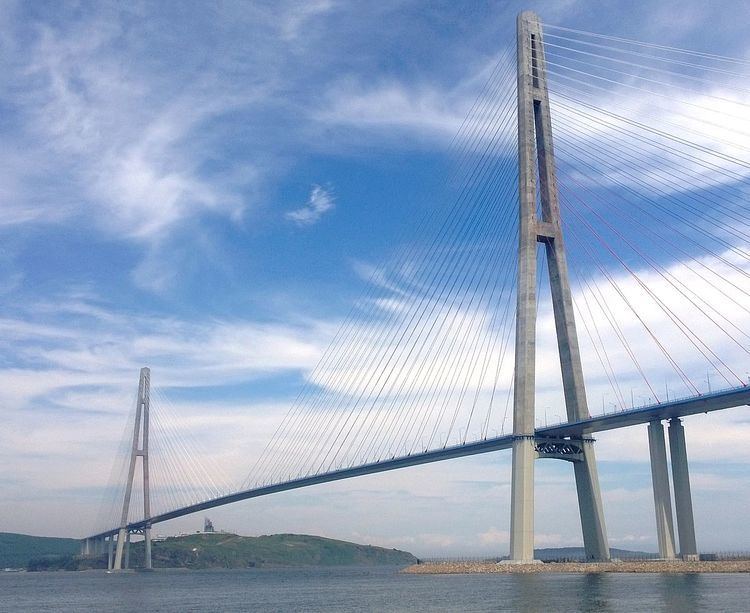Official name Russky Bridge Total length 3,100 m Opened July 2012 | Construction started 2008 Height 321 m | |
 | ||
Carries 4 lanes, (2 lanes each way) Maintained by SK MOST and NPO Mostovik Similar Eastern Bosphorus, Zolotoy Bridge, Zolotoy Rog, Funicular de Vladivostok, Vladivostok railway station | ||
The Russky Bridge (Russian: Русский мост – Russian Bridge) is a bridge built across the Eastern Bosphorus strait, to serve the Asia-Pacific Economic Cooperation conference that took place in Vladivostok in 2012. The bridge connects the mainland part of the city (Nazimov peninsula) with Russky Island, where the main activities of the summit took place. The bridge was completed in July 2012 and opened by Russian Prime Minister Dmitry Medvedev. On September 3, 2012, the bridge was officially given its name.
Contents
Overview
The bridge to Russky Island is the world's longest cable-stayed bridge, with a 1104 m long central span.
The bridge also has the second highest pylons after the Millau Viaduct and the longest cable stays.
The design of the bridge crossing has been determined on the basis of two primary factors:
Bridge specification
Pylons construction
The piles were driven as deep as 77 m below ground and on the island side 120 auger piles were piled under each of the two 320 m high bridge towers.
The pylons were concreted using custom self-climbing forms in pours of 4.5 m. A crane was used on the first three pours, afterwards the formwork was completed unaided moving through the hydraulic motion of modular elements.
The pylons are A-shaped, therefore, the use of standard forms was not feasible. An individual set of forms was arranged for each bridge tower.
Transition between section types was carried out at summer levels at the elevations of 66.26 m and 191.48 m.
The use of self-climbing forms made it possible to achieve better quality and decrease the time of construction of cast-in-situ reinforced concrete structures by half as much again.
The cable stays anchorage zone starts at 197.5 m. The installation of cable stay pairs and casting of bridge tower bodies was carried out simultaneously, dramatically reducing the construction period.
Central span structure
The span structure has an aerodynamic cross-section to assume squally wind loads. The shape of the span cross-section has been determined based on aerodynamic design and optimized according to the results of experimental processing of the scale model in the detailed design phase.
Welded field connections are used for longitudinal and transversal joints of the cap sheet of the orthotropic deck and lower ribbed plate. For joints of vertical walls of the blocks, longitudinal ribs, transversal beams and diaphragms, field connections are used provided by means of high-strength bolts.
Large-sized prefabricated sections for the installation of the central span were delivered by barges to the erection site and hoisted by a crane to a 76 m height. Here, the elements were abutted and cable stays attached to them.
Cable-stayed system
A cable-stayed system assumes all static and dynamic loads on which the very existence of the bridge depends. Cable stays are not designed to endure the entire lifetime of the bridge, but they are repairable and have the best possible protection from natural disasters and other adverse impacts. PSS cable stays consist of parallel strands of 15.7 mm diameter; every strand consists of seven galvanized wires. Cable stays incorporate from 13 to 79 strands. The length of the shortest cable stay is 135.771 m; the longest, 579.83 m. The protective housings of the cable stays are made from HDPE and have the following features: UV resistance; resistance to local climate conditions of Vladivostok (temperature range from minus 40 °C to plus 40 °C) and environmental aggressiveness.
Criticism
The costs and the fact of the construction of the bridge are widely criticized by Russian political opposition. In January 2007, Vladimir Putin, then-President of Russia, stated that holding a summit in Vladivostok is a distinct possibility, and that at least 100 billion rubles would be required to prepare the city for the summit, which, at the time, was three times more than the budget of Primorsky Krai as a whole. As of 2012, the costs of construction of the bridge to Russky Island with population of only 5,000 inhabitants is expected to surpass $1 billion USD. The built-in capacity of the bridge is 50,000 cars per day, which is far more cars than the existing island population has, so the bridge is severely underused. The project description on the site of the general contractor does not list project costs.
There had also been criticism of the fact that the paved road ended in a dead end a short distance beyond the bridge during the first year after it was built.
